Addressed Saturation vs. Targeted Mailing: Which Is Right for You?
November 25th, 2023
7 min read

Have you decided it’s time to try something new in your direct mail marketing efforts? Looking to expand your direct mail reach or even cut back on bad-fit recipients?
If that sounds like you, it may be time for you to explore new mail list options. Whether you need to reach more potential customers or dial your list in to better identify and communicate to the people who would benefit from your goods or services, you should know about the direct mail strategies at your fingertips.
That’s what we’re here to cover. Two popular direct mail strategies include saturation mailing with specific addresses and targeted mailing. Here at Integra, we’ve helped hundreds of customers get their materials into the hands of the right recipients for the situation, and we’ve heavily used both of these direct mail strategies with great success.
We’d be happy to do the same for you, but even if you’re not working with Integra for your print and mail projects, we want to help you understand the direct mail categories and make the right choice for your business and strategy. Who knows — maybe we’ll be the lucky recipients on the other end of your direct mail campaign!
In this article, we’ll cover the following topics in depth:
- What saturation mailing is
- Subcategories within the saturation strategy
- Pros of saturation mailing
- Cons of saturation mailing
- What targeted mailing is
- Subcategories within the targeted strategy
- Pros of targeted mailing
- Cons of targeted mailing
We’ll also link to relevant content along the way related to saving money on your direct mail campaign as well as comparisons between these two mailing strategies and Every Door Direct Mail (EDDM) in case you want a third choice.
Now that you know what to expect, let’s jump right in!
What Is Saturation Mailing?
Before delving into the specifics, let's define saturation mailing. This approach is about casting a wide net — sending your marketing materials to every possible mailbox within a chosen area. Whether you’re trying to reach a small community or a sprawling urban area, saturation mailing can ensure that your message reaches a broad audience without the need for refined targeting.
Bear in mind that two types of saturation mailing exist. One has simplified addresses (Every Door Direct Mail, or EDDM), while the other has specific addresses. Each comes at its own price point.
The saturation strategy we’re focusing on in this article is saturation mailing with specified addresses. We’ll cover EDDM in other posts and ensure the links are available for you to explore.
Categories of Saturation Mailing
With saturation mailing, you can segment your approach in a few different ways. You’ll need to decide on:
- Residential vs. business saturation: Decide whether your focus is on homes, businesses or both.
- Geographical segmentation: Tailor your reach by targeting specific cities and neighborhoods. You can shrink or broaden your reach based on the number of mail pieces you’d like to print and send.
Pros of Saturation Mailing
Now, let's explore the advantages:
- Cost-effectiveness: Saturation mailing's appeal lies in its affordability, especially when you're sending out a high volume of mail. You won’t need to purchase a mail list, and you’ll usually pay less per piece than you would with targeted mailing.
- Extensive coverage: Ideal for widespread messaging, this strategy ensures that nearly everyone in the area is aware of your brand or offer. It’s great for businesses that depend on local residents or businesses, such as grocery stores, restaurants and pharmacies. If you do most of your business out of a brick-and-mortar location, saturation mailing might be a great option.
- Simple design: Sometimes this feature can be considered a negative attribute, but not always. If you’d rather not bother with personalized mail, name-based addresses and mail list data, you’re on the right path with saturation mailing. The choices for what each piece looks like, how large it is and how you address it can get overwhelming for some businesses, especially if they don’t have a print management company to walk them through the options. If that sounds familiar, you may find the guidelines of saturation mailing to be a bit of a relief.
Wondering what Integra Graphics Synergy’s timetables look like? Check out our timeline calculator below to find out!
Cons of Saturation Mailing
Some of the drawbacks of saturation mailing include:
- Lower personalization: The trade-off for this broad reach is a lack of personalization, which can affect how your message is received. Some people tend to see mail pieces without names and immediately file them away as spam, either tossing them or leaving them unread.
- Potential overreach: It's also possible with saturation mailing to reach many individuals who aren’t interested in your offer, which could dilute the effectiveness of your campaign. If your product or service is fairly specific and not applicable to large swaths of people, you may want to choose another direct mail strategy.
- Tight restrictions: Per USPS mailing guidelines, you’ll need to meet a few specified saturation parameters to be eligible for saturation standards. For instance, your mail pieces will need to be flats or letters that weigh 3.5 or fewer ounces. Additionally, you’ll have to meet the 90/75 rule stating that at least 90 percent of active residences and/or 75 percent of operational businesses along your selected carrier route must be included.
- Lack of cross-media capabilities: One exciting development in direct mail over the years has been the cohesive combination of mailed content and digital ads. You can make more impressions and increase your brand awareness with each campaign by reaching your audience in their digital spaces along with the piece you mail out. Unfortunately, this service is not as readily available with saturation mailing, because you won’t have a targeted list of names to use for finding these connections online without extra list purchases.
Let’s switch gears to discuss targeted mailing and how it can play into your marketing approach.
What Is Targeted Mailing?
This strategy takes a more focused approach to direct mail. Instead of reaching everyone, it hones in on specific segments of the population based on chosen criteria. This method opens the door to tailored messaging, directly speaking to the interests and needs of a particular group.
Types of Targeted Mailing
Targeted mailing can be approached in various ways even more so than saturation mailing. Think about the kind of audience you want to reach, and select filters from there. Some categories to consider as you apply your filters include:
- Demographic targeting: Pinpoint your audience by specific demographics, such as age, gender or income. This option casts a fairly wide net, and it’s a great place to start if you’re sure certain demographics won’t be interested in your product or service. If you sell high-end jewelry with premium prices, for example, you may want to set filters that target higher income families.
- Interest-based targeting: You can also target based on interests and behaviors, aligning your message to what resonates most with your audience. For instance, if you specialize in hand tools and fasteners, you could target professionals in the construction industry or known DIYers who tend to handle their own home projects and renovations.
- Previous customer interactions: Leveraging data from past interactions can also guide your targeting strategy. In some cases, you may even be able to stick exclusively with your in-house customer list. Let’s say you have a loyal customer base and a brand new product to show off. It’s the perfect combination for an in-house mail list that allows you to target previously interested parties. You’ll already know their interests and avoid any lack of certainty.
You can always mix and match filters, narrowing your audience in whatever way best suits your business. However, use caution — the more filters you add, the more likely you’ll be to miss interested parties and qualified leads.
Pros of Targeted Mailing
If you know your audience and want to make sure they know about you, targeted mailing might be the strategy you’ve been seeking. Some of the clear strengths of targeted mailing include:
- High engagement: By focusing on a specific audience, your message is more likely to strike a chord and generate a response. It’s easier to sell something to someone when they think, “Hm, that sounds a lot like what I’ve been looking for!” or “That would be super useful in my next project!” As a result, your ratio of send to response is likely to improve, assuming you’ve read your audience right.
- Efficient use of budget: Since you're investing in reaching those most likely to be interested in your offer — which can lead to a higher return on your marketing spend — the better you’ve used your marketing dollars. Especially if you’re able to turn those leads into conversions, you’ll thank yourself for having spent the extra money upfront to get in touch with the right folks.
- Ability to make cross-media impressions: The heart of targeted mailing is that it uses a mail list, which means an opportunity to match the names and addresses on that list with digital spaces associated with each person. Integra’s version of this type of omnichannel marketing is called SynergyMail and can help you make more impressions per campaign for limited additional spend. Many other printers and print brokers offer similar programs — a major perk of targeting.
Cons of Targeted Mailing
On the flip side, some of the challenges you might face with targeted mailing include:
- Higher costs: Tailoring your message and acquiring specific mailing lists can increase your cost per mail piece. You’ll also typically see higher print prices per piece with smaller orders, since you won’t get the advantage of bulk printing prices. If your targeted list is large enough that it’s comparable to the larger saturation mailing numbers, you may be able to disregard this factor. Finally, your postage rates will be higher with targeted mail.
- Research intensive: Targeted mailing requires a deeper understanding of your audience, necessitating thorough research and data analysis. This means extra time and effort working out the details of your campaign and who it would go over best with. An experienced direct mail expert can help define what you’re looking for and purchase the correct lists for your objectives, saving you time and researching effort in the process.
- More time-intensive: Along with the time added to your project during the consumer research phase, you’ll need to put more time into making decisions about your designs and deciding the best way to address each piece. Depending on your chosen design and address methods, your printer may need additional time to produce your work.
Which Type of Direct Mail Strategy Fits With Your Next Campaign?
In our digital era, direct mail continues to stand out as an effective marketing medium, known for its physical presence and ability to connect with recipients on a different level. As you explore direct mail for your marketing endeavors, it's crucial to understand the distinct strategies available, including saturation mailing and targeted mailing.
When you made your way to this blog listing, you may not have known the unique benefits and drawbacks of saturation and targeted mailing — or perhaps that the two categories existed at all! Selecting the right approach can be pivotal in achieving your marketing objectives, which is exactly why we wrote this piece to begin with.
Choosing between saturation and targeted mailing depends on your specific marketing goals, audience and budget. Saturation mailing excels in broad reach and cost-effectiveness, while targeted mailing offers precision and relevance. Now that you understand both methods, you should be able to tailor your direct mail campaign — and all that follow — for maximum impact.
If you don’t quite see the best fit here, remember that other options exist in the direct mail marketing landscape. You may want to learn more about how targeted mailing stacks up against Every Door Direct Mail (EDDM) campaigns.
Still weighing which direct mail strategy is right for your business? Click below for a personalized consultation from a print management partner who can plan with you, provide high-quality mail lists, print your best content and ultimately get your materials into the hands of your top prospects.
We’ll wait by the phone just in case!
Topics:



























